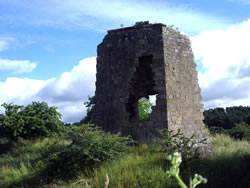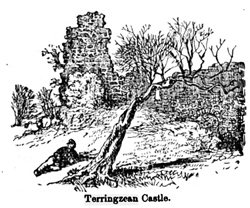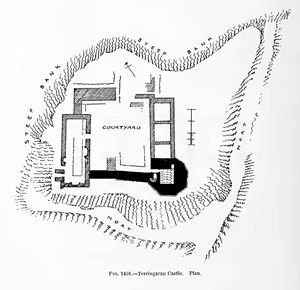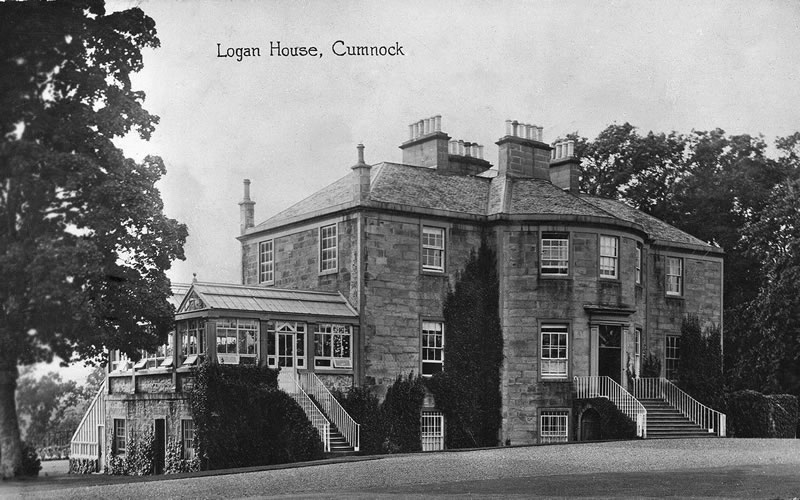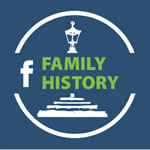Country Houses, Villas and Castles
Cumnock and the surrounding area boast of several important Estates and buildings which served a variety of purposes over the past four centuries - many of them still existing today. Below are some some of our oldest and most cherished.
Researched by Bobby Grierson
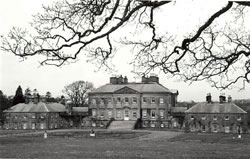 Dumfries House was built between 1754-9 for William Dalrymple, 4th Earl of Dumfries by John, Robert and James Adam. It was the Adam Brothers first important independent architectural commission and they kept the building costs to within a few pennies of the original estimate of £7979 11s 2d. The house - which stands on the left bank of the Lugar Water - is built of a fine quality close-grained sandstone. The main entrance is reached by a very wide flight of steps and leads to a large entrance hall. The frontage is three storeys high with large wings at each end containing further rooms. James Armour who later became Robert Burns’ father-in-law was reputedly employed in the work.
Dumfries House was built between 1754-9 for William Dalrymple, 4th Earl of Dumfries by John, Robert and James Adam. It was the Adam Brothers first important independent architectural commission and they kept the building costs to within a few pennies of the original estimate of £7979 11s 2d. The house - which stands on the left bank of the Lugar Water - is built of a fine quality close-grained sandstone. The main entrance is reached by a very wide flight of steps and leads to a large entrance hall. The frontage is three storeys high with large wings at each end containing further rooms. James Armour who later became Robert Burns’ father-in-law was reputedly employed in the work.
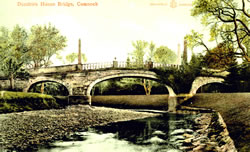 Avenue Bridge, a three arch bridge adorned with obelisks is contemporary with the house, but a lovely dovecote dates from 1671. Other structures on the Estate include 2 single-arch bridges, an icehouse, a coach building, a sundial, the ruins of Terringzean Castle, lodges, and a temple.
Avenue Bridge, a three arch bridge adorned with obelisks is contemporary with the house, but a lovely dovecote dates from 1671. Other structures on the Estate include 2 single-arch bridges, an icehouse, a coach building, a sundial, the ruins of Terringzean Castle, lodges, and a temple.
The wings of the house were never completed to the Adams’ design but were later finished in 1905 by Robert Weir Schultz for the then Marquess of Bute.
In the 19th century, Dumfries Estate covered the greater part of Old Cumnock and adjoining parishes, amounting in 1872 to a total of 43,734 acres. This was exceeded in Ayrshire only by the Marquess of Ailsa who owned 76,000 acres. The Dumfries Estate had a gross annual value of over £22,000 plus over £2,500 of mineral value.
The House was rescued in 2007 for the nation by a consortium headed by Prince Charles.
You can read the pdf news articles about this HERE
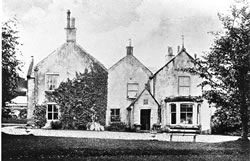 Garrallan was owned by the Campbell family until 1676 - the Douglas family followed but it became extinct in the male line. Jane Douglas married Hamilton Boswell and this family retained it until 1914 when it was sold to the Stevenson family of Changue.
Garrallan was owned by the Campbell family until 1676 - the Douglas family followed but it became extinct in the male line. Jane Douglas married Hamilton Boswell and this family retained it until 1914 when it was sold to the Stevenson family of Changue.
Dr. Patrick Douglas (died 1819) also owned property in Jamaica and he offered work to Robert Burns in 1786 - but the poet declined. Burns was a visitor at Garrallan.
For more information on the Douglas Boswell family of Garrallan - see the People section
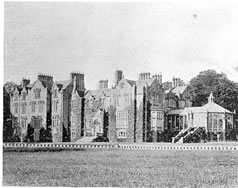 Built around 1833, Glaisnock House was designed by James Ingram of Kilmarnock for James Allason, the owner at the time. The house has been extended since. In the mid 19th century the Estate passed from the Allason family to Captain Robert Campbell of Auchmannoch in the parish of Sorn.
Built around 1833, Glaisnock House was designed by James Ingram of Kilmarnock for James Allason, the owner at the time. The house has been extended since. In the mid 19th century the Estate passed from the Allason family to Captain Robert Campbell of Auchmannoch in the parish of Sorn.
The estate was broken up around 1949, the mansion and its immediate policies being bought by the county council and opened in 1952 as a junior secondary school. Taking boarders as well as day pupils, the school specialised in rural education and was much beloved of farmers.
In 1968 it was upgraded to a four-year school, but it was closed in June 1973. It subsequently became a residential centre for outdoor studies.
The future of the House looks uncertain.
Scotsman 3rd June 1948
AYRSHIRE PARISH OF OLD CUMNOCK
For sale by private bargain the attractive residential and agricultural estate of GLAISNOCK, situated on the upland hills 1 ½ miles south of Cumnock and 17 miles from Ayr, briefly comprising 1, substantial mansion house with 5 reception rooms, 12 bedrooms, 5 dressing rooms with ample bathroom and WC accommodation; suitable staff bedrooms and domestic offices; American skittle alley and billiard room suite; electricity and central heating throughout; 2. Stable and garage buildings to take 4 cars; laundry &c. 3. 3 four apartment cottages and entrance lodge; the policies which extend to 107 acres include ornamental woodlands, glen, excellent walled garden and about 70 acres of good pastureland. Total rental £136 10s; stipend, £1. Early entry can be arranged. Further particulars and arrangements to view from Messrs R D Hunter & Co Solicitors, Commercial Bank Buildings, Cumnock with whom offers should be lodged. Tel 2118.
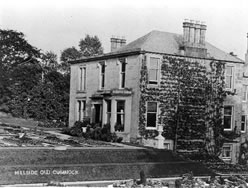 Hillside House was built in 1846 by the Crichton family. Adam Crichton had been factor to the Marques of Bute and his son Hew Crichton became head of the Edinburgh firm Tait & Crichton, Writers to the Signet. The third generation was James Arthur Crichton an advocate who became Sheriff of the Lothians and Peebles. Hillside House was tenanted by his brother Hew Hamilton Crichton and his sister Margaret and it was Margaret who went on to fund the building of the Crichton West Memorial church in Ayr Road in memory of her father and brother. Hillside House was purchased by the School Board for £1,500 after Margaret died in 1908.
Hillside House was built in 1846 by the Crichton family. Adam Crichton had been factor to the Marques of Bute and his son Hew Crichton became head of the Edinburgh firm Tait & Crichton, Writers to the Signet. The third generation was James Arthur Crichton an advocate who became Sheriff of the Lothians and Peebles. Hillside House was tenanted by his brother Hew Hamilton Crichton and his sister Margaret and it was Margaret who went on to fund the building of the Crichton West Memorial church in Ayr Road in memory of her father and brother. Hillside House was purchased by the School Board for £1,500 after Margaret died in 1908.
This large and impressive villa stood in extensive and beautifully kept garden grounds and included conservatory, vinery and greenhouse. The house was converted for use as a Higher Grade School for a further £2,000 and accommodated around 150 pupils and opened in 1911.
Lower school classrooms were situated on the ground floor and upstairs the higher school classrooms and art department, which had been created by the removal of internal walls and enlargement of some windows. There was a model parlour, kitchen and bedroom for domestic science, a classroom for training in manual subjects while out in the extensive grounds, school gardening was taught in the attractive formal gardens.
In 1927 Cumnock Public and Higher Grade Schools were re-named Cumnock Academy. At that time 919 pupils, both secondary and primary attended the school. There were 31 teachers, 4 part-time, teaching 8 subjects.
By this time the gardens of Hillside House had almost disappeared as another new wing was added in 1939 to form a U-plan and Hillside House itself was demolished.
Also featured in the gallery on Cumnock Higher Grade School HERE
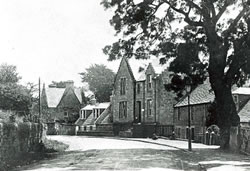 James Keir Hardie moved to Cumnock c1880, the year he married Lillias Balfour Wilson of Hamilton. They lived in a cottage in the area now called Keir Hardie Hill off Barrhill Road
James Keir Hardie moved to Cumnock c1880, the year he married Lillias Balfour Wilson of Hamilton. They lived in a cottage in the area now called Keir Hardie Hill off Barrhill Road
In 1887 one of Keir Hardie's supporters, Adam Birkmyre offered Hardie a loan and Lochnorris the family home was built. It cost £600.
It was in Cumnock that Hardie formed his political philosophy. Many of his speeches and writings were composed in the solitude of his summerhouse at the bottom of the garden, overlooking the River Lugar. Hardie brought up James, Duncan and Nan at Lochnorris, living there until his death in 1915.
Hardie’s wife Lillie died in 1924. Nan married Emrys Hughes in 1924 and they lived at Lochnorris, both becoming active in politics - with Nan becoming Provost of Cumnock and Emrys becoming MP for South Ayrshire. After Nan`s death 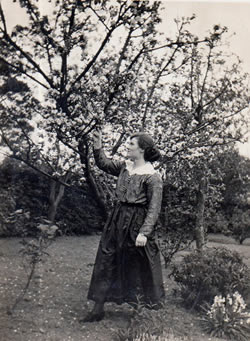 Emrys Hughes remarried in 1949 to Martha Cleland and it was Martha who bequeathed the Lochnorris collection to Cumnock and Doon Valley District Council in 1982. The Lochnorris Collection is now managed by East Ayrshire Council and some of it can be seen at the Baird Institute. Lochnorris was sold in 1983 and is still a private residence. Martha died later that year.
Emrys Hughes remarried in 1949 to Martha Cleland and it was Martha who bequeathed the Lochnorris collection to Cumnock and Doon Valley District Council in 1982. The Lochnorris Collection is now managed by East Ayrshire Council and some of it can be seen at the Baird Institute. Lochnorris was sold in 1983 and is still a private residence. Martha died later that year.
The Keir Hardie Family Album with photos of the family at Lochnorris is HERE
By Bobby Grierson
Logan (Scottish Gaelic: An Lagan) was a country estate a mile and a quarter east of Cumnock, by the Lugar Water. Comprising of 3,783 acres and valued in the mid nineteenth century at £1,967 annual value plus £860 for minerals.
Logan of that Ilk
The leading Logan family's principal seat was in Lastalrig or Restalrig, near Edinburgh. Sir Robert Logan of Restalrig married Katherine Stewart, daughter of Robert II of Scotland and later in 1400 Sir Robert was appointed Admiral of Scotland. Sir Robert Logan was one of the hostages given in 1424 to free James I of Scotland from being held in England. Robert's son or grandson, John Logan of Restalrig, was made principal sheriff of Edinburgh by James II of Scotland. In 1555 Logan of Restalrig sold the superiority of Leith (the principal seaport of Edinburgh) to the queen regent Mary of Lorraine, also known as Marie de Guise.
The last Logan to possess the barony was Robert Logan of Restalrig, who was described by contemporaries as "Ane godless, drunkin, and deboshit man". Sir Walter Scott described him as "one of the darkest characters of that dark age".
HUGH LOGAN, of LOGAN, was lineally descended from the ancient and once powerful Barons of Restalrig, whose wide-spread domains were forfeited in the reign of James VI. In the year 1660, Sir Robert Logan, a grandson of the fore mentioned Baron, effected a purchase of a large portion of the barony of Cumnock, to which he gave the family name. This extensive and valuable property descended through a line of respectable ancestry to the subject of our present notice, who was born at Logan House in 1739.
From his earliest years, Hugh Logan was of a quick, volatile, and somewhat irritable disposition and although every facility was affordable to him for acquiring that education becoming his rank in society, yet either from his unmanageable temper, or the want of a proper system of discipline on the part of his teachers, it was found impossible to obtain even the slightest degree of application to his academic exercises. While his boyish years were passing away in this unprofitable manner, being the youngest of three sons, his father frequently urged him to adopt some useful profession. On these occasions his uniform answer was, "I’ve made up my mind, Laird, to follow nae trade but your ain.'' "Weel, weel, Hughie,'' the good natured old gentleman would say, "I was the youngest o' three myself." and, strange as it may appear, the coincidence was realized - his elder brothers both died in early life-and on the decease of his father, which took place soon after, Hugh succeeded to the estate under the control of tutors or guardians, who do not appear to have been more successful in forwarding his instruction than those who had formerly been entrusted with it; for although he was sent to Edinburgh for the purpose of repairing the defects which his own aversion to study and the negligence of his father had occasioned in his education, yet he returned to his country pursuits with literary acquirements scarcely superior, if even equal, to those of the meanest mind upon his estate. Though the cultivation of the young Laird's mind had been thus neglected, it was not so with those external qualities which he possessed. In all field sports he was considered an adept, while in doing the honours of the table he was acknowledged to have been almost without a rival, and such was his natural quickness and ingenuity that when the errors of his education chanced to make their appearance few of his companions would venture to notice them, as they well knew he would either turn the laugh in his favour by some humorous palliation of his ignorance or render them ridiculous by making them the butts of his wit for the time being - a distinction seldom considered as very enviable. There is one well-known anecdote which, as it illustrates this part of his character, our readers may perhapss excuse our noticing. Logan had occasion one day to write a letter in the presence of a school companion, who, on looking over it, expressed his surprise at the singularity of the orthography. "It is strange, Logan," said he, "that yon cannot manage to spell even the shortest word correctly." "Spell! " cried the Laird, with a look of well-feigned pettishness, "man, what are you haverin' about? look at that!'' holding up the stump of a quill to him; " would ony man that kens ony thing about spelling ever attempt to spell wi' a pen like that? " This anecdote is generally, though erroneously, ascribed to the late eccentric Laird of McNab.
As another instance of the archness peculiar to our uneducated wit, we may mention the following. The plantations of Coilsfield having been much injured by the wanton depredations of some evil-disposed vagrants, Mr Montgomerie, the proprietor, brought the case before a meeting of the Justices, of which Sir Andrew Ferguson and the Laird of Logan formed part. On investigating the case it appeared that the damage had been the work of children, and in consequence the complainer could obtain little or no redress. Sir Andrew, feeling the hardship of the case, and by way of soothing a brother proprietor, observed with some warmth that he would have a Bill brought into Parliament for making parents liable for the misdeeds of their children, and constituting such offences as the above felony in law. At this declaration, Logan broke out into a loud laugh; and, being asked the cause of his merriment, replied, "Sir Andrew, when your bill is made law, we shall soon have few old lairds among us.'' "Why?" demanded the other. "Because," said the wit, "their eldest sons will only require to cut their neighbours young plants to become lairds themselves."
New Statistical account 1845 - Rev Ninian Bannatyne
Hugh Logan, Esquire of Logan, the famous Ayrshire wit, resided during the greater part of his life, on his estate in this parish; and there is a stone, near to the house or Logan, which goes by the name of Logan's pillar, where, it is said, he was much in the habit of sitting, and cracking his jokes with those around him. His numberless witticisms and sarcasms, which were oftentimes pregnant, not only with the most genuine humour, but likewise marked by an eagle-eyed discrimination, as well as an unsparing dissection of character, and conduct, are generally current among the people of this district, and form an unfailing source of amusement at their jovial meetings. But, from the frequent mixture or coarseness and profanity that interlard them, they have by no means contributed to promote the interests; either of religion or morality, in the neighbourhood.
The last Logan of Logan, Hugh Logan was celebrated for both his wit and eccentricity. Logan was known for his amusing anecdotes and puns. He had one illegitimate daughter, who married a Mr. Campbell.
Logan House
Logan House, beautifully situated among trees on the elevated left bank of the Lugar Water, one mile and a quarter east of Cumnock, has a pleasing association with the greatest extemporaneous wit and humorist of Scotland, Hugh Logan, The Laird o’ Logan. It is now the, property of Cunninghame.
William Allason Cuninghame, Esq. (b. 1805), holds 3783 acres in the shire, valued at £2836 per annum. The famous Ayrshire wit, Hugh Logan, better known as the Laird of Logan, passed most of his life on the estate.
A house and small tree-lined enclosure are recorded in the mid 18th century. A new house was built in the late 18th century and the designed landscape extended. By the mid 19th century a boundary strip enclosed some hill land, blocks of planting, the house, walled garden and outbuildings.
Strips of boundary planting are all that remain of the 18th and 19th century designed landscape associated with the house at Logan. The western part of the estate was redeveloped for housing after the house was demolished.
Download Logan History Groups booklet HERE
By Bobby Grierson
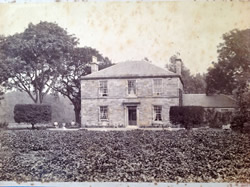 Built about 1860 by Daniel King who lived there with his wife Isabella and 7 children, Helen, Isabella, Marion, James, William, Jane and Annie and 2 servants. He was a Woollen Manufacturer employing 5 men and 4 women. Daniel was one of the first Commissioners of the new Burgh in 1866. In 1871 he was a Junior Police Magistrate and a Woollen Manufacturer employing 36 men and 12 girls. He served on the Council for 9 years from 1866-1875. In 1881 he was still at this address with his family as a Woollen Manufacturer employing 20 men and 15 boys.
Built about 1860 by Daniel King who lived there with his wife Isabella and 7 children, Helen, Isabella, Marion, James, William, Jane and Annie and 2 servants. He was a Woollen Manufacturer employing 5 men and 4 women. Daniel was one of the first Commissioners of the new Burgh in 1866. In 1871 he was a Junior Police Magistrate and a Woollen Manufacturer employing 36 men and 12 girls. He served on the Council for 9 years from 1866-1875. In 1881 he was still at this address with his family as a Woollen Manufacturer employing 20 men and 15 boys.
Daniel King, now a widower died in 1882 at Millbank aged 75 and in 1895 his son James was now owner occupier having succeeded on his father’s death to the Lugar Woollen Mills and Carmacoup Woollen Mills in Douglas, Lanarkshire. James died suddenly on 26 March 1888 in his early 40’s, of a heart attack at St Enoch’s station in Glasgow.
Daniel King’s eldest daughter Helen married James Morrison in October 1888. At that time he his residing at Hillside House and a Physician and Surgeon, his wife residing at Beachworth Villa in Dunoon. They were married at Holmside House, Cumnock. Helen died in March 1893 and by 1895 James Morrison was now owner occupier. By 1901 he was retired and living at Blackbush Cottage, Doctors Road, Ochiltree and in 1905 James Morrison had leased the house to Mrs Agnes Logan, or Climie. James died in October 1911 at Blackbush Cottage, his paternal family home.
By 1911 Robert Livingstone, Licensed Grocer was now owner occupier. And living there with his wife Agnes and 3 children, Marion, Jane and James. In 1918 his son James was a sergeant airman in the RAF and giving his address as Millbank. In 1920 Robert Livingstone was still owner occupier but Robert died in September 1928.
His son James was living here on 30 Aug 1930 when his mother Agnes died. The building was purchased by the District Council shortly after that in 1931 as a County Registry Office.
In 1937 a branch of the County Library was opened in the grounds of Millbank House in a new building with child welfare clinic attached. In 1935 a Scout and Guide Hut was also opened in the grounds at Millbank.
Millbank House operated as the Cumnock County Registration Offices for births, deaths and marriages until Rothesay House at Greenholm Road opened in 2013.
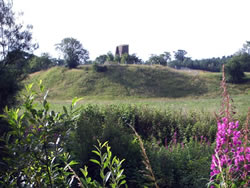 Situated on the banks of the river Lugar to the West of Cumnock, Terringzean can now be seen from the Cumnock bypass and on the grounds of Dumfries House Estate.
Situated on the banks of the river Lugar to the West of Cumnock, Terringzean can now be seen from the Cumnock bypass and on the grounds of Dumfries House Estate.
Pronounced "Tringan" this now-ruined castle was partly built in the 15th century. The earliest reference to it dates from 1438 when £14 Scots was paid in tax to support the royal household. A Charter dated 26th April 1467 was awarded to Thomas Boyd, Earl of Arran for the lands of "Trarinzeane". Thomas`s wife Mary was the sister of King James III.
The lands later became the property of the Crawfuirds of Leifnoreis and for a time was known as Crawfuirdstone. In 1563 they resigned the lordship to Sir Matthew Campbell of Loudoun who signed the Protestant Bond of Union in 1559. The lands were bought by Lord Dumfries in 1696.
The Castle was excavated in the 1890s by the 3rd Lord Bute. The tower, which has walls ten feet thick, is the oldest part shown as black on the plan. Lesser wings have stood to the north and west of it, creating a courtyard. The Castle was partly surrounded by a moat, with steep embankments on other sides.
